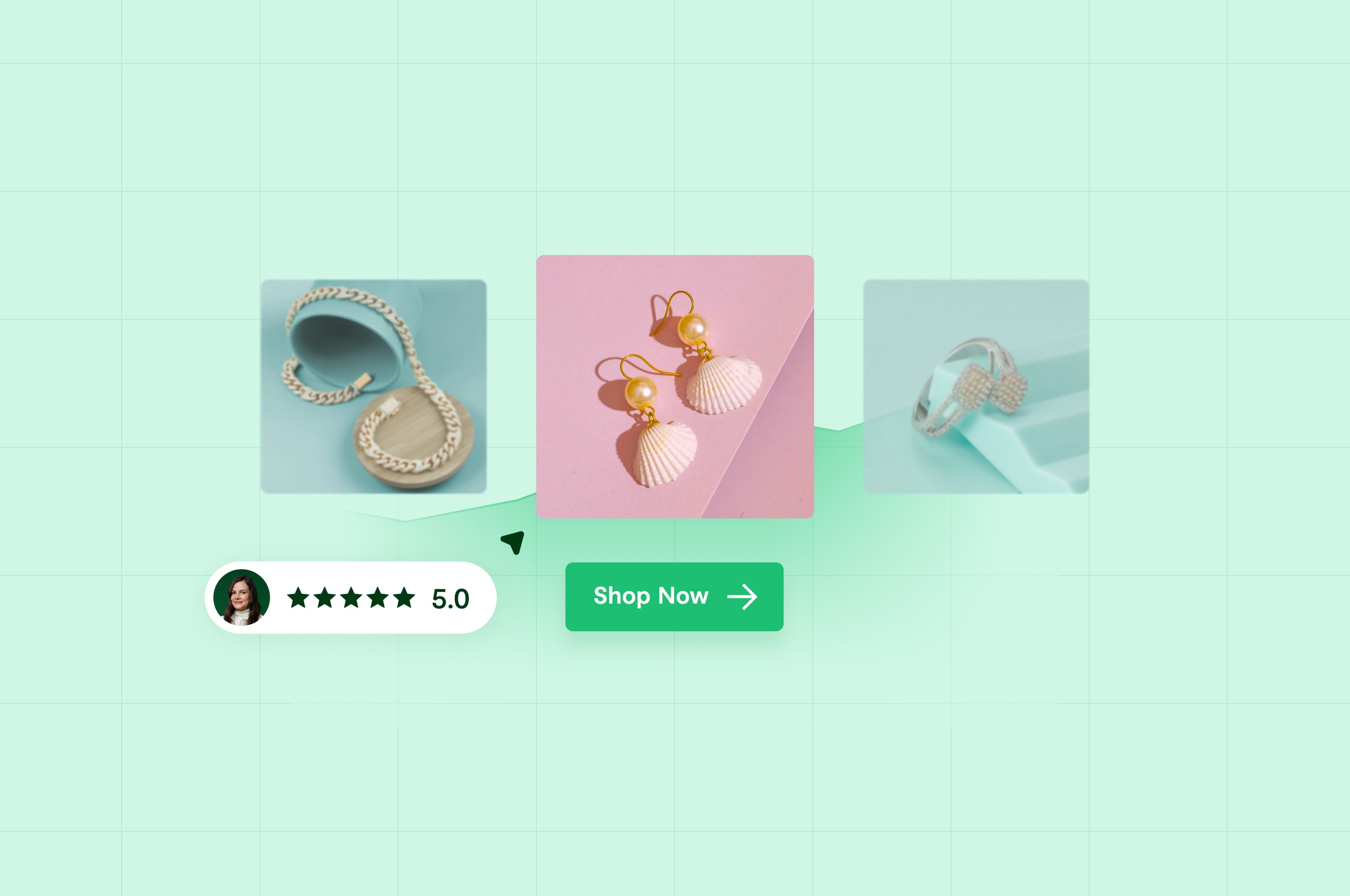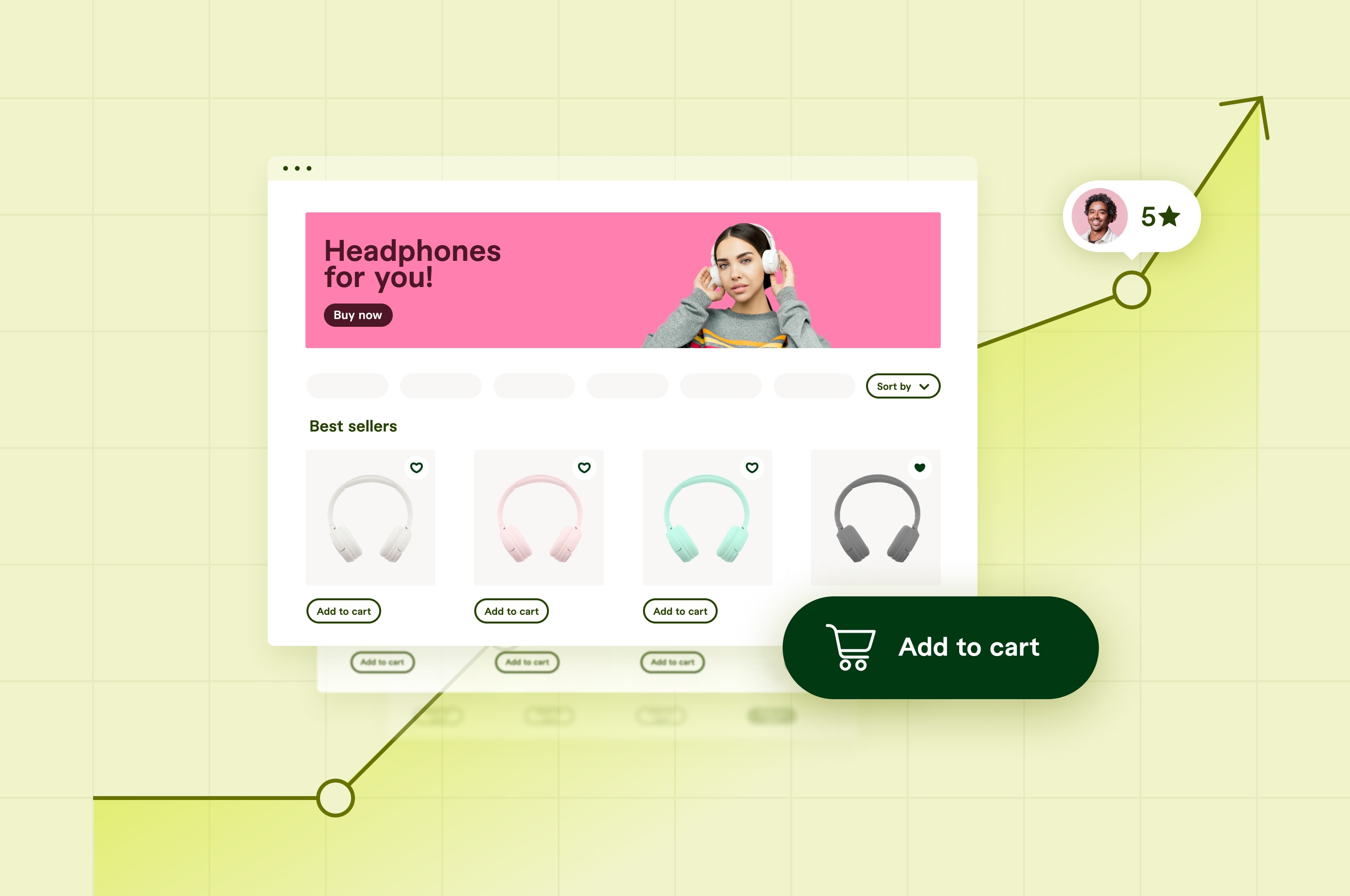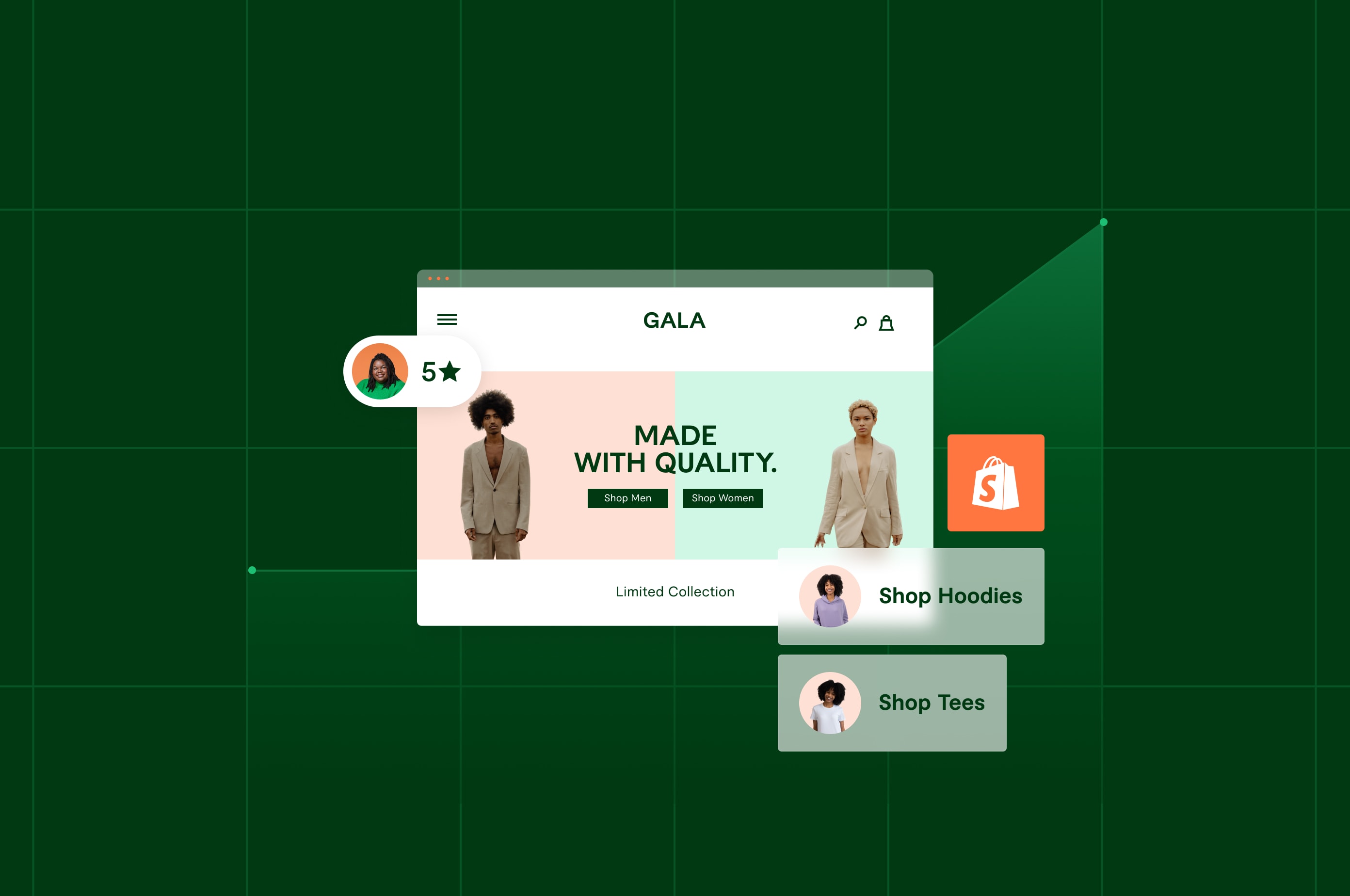Start a Jewelry Business In 7 Steps (2024)
Starting a business has never been easier than in 2024. Launch your own jewelry line by following these seven steps.
 March 1, 2024
March 1, 2024 10 minute reading
10 minute reading
The jewelry market is booming and shows no signs of slowing down. In 2023, revenue for the jewelry industry was projected to reach $298.4 billion.
Customers are buying both fine jewelry and everyday pieces, giving you lots of options for product offerings.
Entrepreneurs wanting to start their own jewelry business can do so in seven simple steps. In this step-by-step guide, we’ll cover how to launch a successful startup in the jewelry market and how to continuously optimize your business strategy.

Don't get down to business without a plan, hire a business plan writer on Fiverr today.
Hire an expert1. Decide on your jewelry niche
A jewelry line is one of the top ecommerce product ideas. Like any other ecommerce business, you need to get specific with your product offerings. Selecting a niche doesn’t inhibit the development of your business. It enables you to hone your advertising to reach your target audience more directly. Compared to a wide, general market, niches have fewer competitors, making it simpler for small entrepreneurs to start their own business.
There are a few niche jewelry categories to consider:
Handmade jewelry. People find handmade jewelry attractive due to its distinctive nature, making it difficult to replicate. While it can be more costly to set up this type of business—especially because you can’t rely on dropshipping—you can earn yourself a loyal consumer base.
Fine jewelry. Fine jewelry is high quality and usually made with precious metals or gemstones. The cost of fine jewelry is usually more expensive, and customers tend not to buy in bulk, making it a more difficult niche for small business owners to enter.
Fashion jewelry. Also known as costume jewelry, fashion jewelry has a lower price point than fine jewelry and is more suitable for everyday wear. It’s easier to manufacture, as it can be mass-produced and is more marketable to the general consumer.
Your products will depend a lot on your ideal customer demographics. If you want to sell to high-earning individuals looking for occasion-specific pieces, then you’ll want to make fine jewelry. If you’d rather sell to middle-class individuals who want to add more jewelry to their everyday collection, then fashion jewelry is the way to go.
Now that you’ve conducted the appropriate market research, you can start writing up your business plan and considering the type of jewelry products you’d like to offer, such as:
Earrings
Necklaces
Brooches
Rings
Bracelets
Anklets
Watches
Cufflinks
Engagement rings
Pendants
2. Establish your branding
Running a successful jewelry business requires more than just selling beautiful pieces—it requires creating a unique and recognizable brand that reflects your company’s mission and values. Establishing a strong brand identity is key to differentiating your business from competitors in the jewelry industry and attracting potential customers.
Once you’ve decided on a business name, create a logo that reflects your jewelry brand’s mission and offerings. A good ecommerce logo showcases your brand’s personality and is easy to understand and remember. Test your logo out on different mediums—it should look good on everything from print ads to social media posts.

The Chanel logo represents the luxury brand’s commitment to elegance and sophistication.
Choose colors, fonts, and styles that fit with your branding. Tiffany & Co. took the importance of color to a new level by trademarking the robin’s-egg blue as “Tiffany Blue.” This color is present on all its branding and packaging. Not only does the color make consumers think of the associated brand, it also evokes a feeling of exclusivity, which further represents Tiffany & Co.’s mission and values.

The iconic, trademarked Tiffany Blue packaging.
Next, brainstorm a slogan or tagline that captures the essence of your business. For example, Cartier’s tagline is “Never imitate, always innovate.” Your slogan should be something unique and memorable.
Keep your branding consistent across all pages of your site and all advertisements or social media posts. If you decide to evolve your brand, make sure you update it everywhere so your customer base doesn’t get confused.
3. Source or produce your products
Research suppliers and manufacturers of jewelry materials and products to understand the costs associated with sourcing or producing your own. Those interested in starting a jewelry dropshipping business should follow these six simple steps.
If you’re looking to produce your own pieces, there are different types of production techniques, including:
Wire wrapping
Metalsmithing
Hand-beading
Engraving
Stamping
Carving
Casting
Using high-quality materials for your jewelry results in pieces that stand out from those of competitors in the jewelry market. Precious metals such as gold and silver can be expensive, but they last longer than non-precious metals like brass or copper. Quality gemstones are also important for creating unique pieces that have value. It’s essential to research potential suppliers for these materials to stay within budget while still finding high-quality options.
If you want to engage in dropshipping, it’s important to factor in labor costs and time involved when making decisions about what production methods you use. If you choose to produce your own pieces, you may need additional staff who have the necessary skills and experience in jewelry making. If you choose a manufacturer or supplier, you’ll need to consider the cost associated with outsourcing this work.
4. Set up an ecommerce store
New businesses need to launch an online jewelry store if they want to engage their target market as effectively as possible. Your online storefront should be aesthetic and functional.
Know your goals, budget, and ideal features before selecting an ecommerce platform. Compare popular platforms like Shopify, BigCommerce, and Wix. Flexibility is key—your customers should be able to pay via credit card, PayPal, or Apple Pay if you want to optimize your sales. You should also use a template to set up your store and ensure it’s visually appealing.
Once you’ve decided on a platform, follow these steps to set up your online store:
Choose a custom domain name.
Create product pages.
Write product page descriptions.
Use best ecommerce SEO practices.
Integrate a secure payment gateway.
Ensure you have adequate customer service options.
Add sales channels (like Etsy, Amazon, or eBay).
Manually test the checkout process.
Confirm your store is functional before making it public.
For more information on creating an ecommerce store for your jewelry line, check out our guide on how to start an ecommerce business in 2024.
5. Figure out your pricing
Researching the prices of similar pieces from competitors is a great place to start, but it doesn’t need to inform your decision entirely. Think of it as a way to learn what price range customers are expecting and help set competitive prices that fit within your budget.
“Our pricing strategy is based on production costs—raw material costs and overheads, and a fair profit margin,” says Nikhil Jogia, managing director of Jogia Diamonds, Australia’s oldest diamond merchant. “This gives us an accurate foundation for our pricing, independent of competitors’ pricing strategies. It also provides the flexibility to adjust prices based on market conditions.”

Jogia Diamonds offers customers the ability to customize their rings.
Once you understand the market price, you can then decide on production costs. For handmade jewelry, consider:
Materials
Labor costs
Tools or equipment needed for production
For mass-produced jewelry, it’s important to factor in manufacturing costs and transportation and shipping fees.
The next step is selecting a pricing model that makes sense for your business type. If you are selling custom pieces or one-of-a-kind jewelry items, then it may make more sense to charge customers based on the complexity of each piece.
You must also consider additional fees, such as taxes and shipping, when setting your prices. These additional fees can add up quickly, so it’s important to include them in your calculations when setting your pricing model.
Carefully decide on a profit margin for each product sold that ensures you are making enough money off each item while remaining competitive in the marketplace.
6. Market your jewelry business
As a jeweler, you might depend on in-person sales and your ecommerce website sales. It’s important to use both digital marketing strategies and traditional marketing strategies to grow your consumer base.
Digital marketing strategies
When marketing yourself online, try a mix of these digital marketing strategies:
Email marketing. There are four billion daily email users, making email marketing one of the most lucrative ways to get your online jewelry business in front of customers. Check out these eight email marketing examples for inspiration.
Social media. Post engaging content that resonates with potential customers, while also showcasing your products in a professional—or casual—manner. The tone of your posts depends on whether you’re posting on Facebook, LinkedIn, TikTok, Instagram, or another social media platform.
Search engine optimization (SEO). If you want to acquire customers organically, you need to invest in SEO marketing. Conduct keyword research and write quality content to rank higher on Google’s search engine results page.
Influencer marketing. Influencers in your niche can help you build credibility and earn new customers. Eighty-one percent of consumers have researched, purchased, or considered purchasing a product after seeing friends, family, or influencers post about it.
“You have to optimize your product pages with a detailed description of the product and details about the making of the product and shipping and services you offer to the clients,” says Nicolas Tranchant, the founder and owner of jewelry brand Vivalatina. “In general, my product descriptions are 650 to 700 words long and generate traffic on their own.”

Example of a product page description on Vivalatina’s website.
Traditional marketing strategies
If your business model involves producing your own jewelry, take advantage of craft fairs and local markets. Getting your physical jewelry pieces in front of potential customers is a great marketing strategy, and you can also reach out to local boutiques to sell your pieces.
Hire a designer to create business cards for your jewelry company. You can also take product photos at these events and repurpose them as marketing materials online. Refine your brand’s look and improve credibility with freelance professional product photography.
Other traditional marketing strategies include:
Television advertisements
Flyers
Event marketing
Print advertising
Referral coupons
“We promoted an in-store event last month that led to a huge influx of new customers,” says Jeff Moriarty, owner of Moriarty’s Gem Art. “We used social media mainly to push new customers from the town our store is in. We actually use Fiverr to help us with the banners and social media ads. We are not good at graphic design, so a good freelancer helps a lot!”

Moriarty’s Gem Art website advertises its digital offerings as well as its physical store.
7. Continue to optimize your business strategy
As a small business owner, you know that running a business on your own takes continual work. Prepare to constantly update your business strategy as you learn what works and what doesn’t through trial and error.
“For those starting in the jewelry business, I advise focusing on building a brand that stands for quality and authenticity,” says Jogia. “Understand your market, invest in building strong customer relationships, and be prepared to adapt to changing trends. Your passion for the craft and business acumen will be your greatest asset.”
Some easy ways to optimize your business strategy include:
Integrating artificial intelligence (AI) features like an ecommerce chatbot for customer service
Developing an app for your jewelry business
Designing and launching new jewelry designs
Testing new marketing methods and materials
Adjusting to changing market trends and needs
Continuing to create high-quality content for social media and other digital marketing avenues
If you’re running your jewelry business on your own, or with a very small team, consider enlisting some additional help. This doesn’t have to mean bringing on costly full-time employees.
Partner with expert freelancers who can do everything from designing your website to writing your business plan to writing your product descriptions. Join Fiverr to access a growing global marketplace of specialized freelancers.



